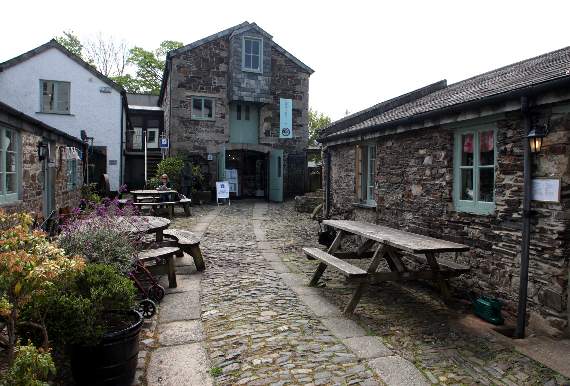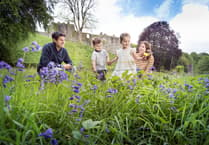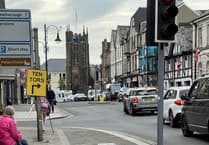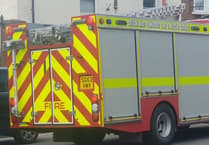Times reporter John Hutchins takes a trip to the Museum of Dartmoor Life and tries not to make an exhibition of himself.
FOR residents and visitors alike, what could be claimed to one of West Devon’s public ‘treasures’ can be unearthed just off the busy main road which runs through the ancient market town of Okehampton.
Next to the White Hart Hotel in West Street is an imposing set of solid iron gates with the words ‘Museum’ forged onto it; once through, the visitor is immediately transported back to times past along a cobblestone and flagstone path to a courtyard where they are ’greeted’ by town benefactor Sydney Simmons himself — (1840-1924) in the form of a life size statue of the man who gave so much to the town and whose splendid park still bear his name today.
As a man who was born in one of the buildings there — now a tea shop — perhaps the great man is keeping a benevolent eye on the museum, a project he would have surely, gladly endorsed.
A series of buildings which date back to the early 19th century houses the Museum of Dartmoor Life. Extending over three floors, its fascinating collection and interactive displays bring to life "the people’s story" for visitors of all ages. Highlights include a reconstructed Bronze Age hut, Victorian kitchen, blacksmith’s shop and farming exhibits.
The museum provides continuous displays and temporary exhibitions, events and guided tours throughout the season.
Andrew Thompson, the museum manager, is keen to emphasise that the resource is very much part of the wider community and not just a place to exhibit local heritage but to entertain, inform and stimulate the visitors who come through its doors.
He told the Times: ‘We were set up 35 years ago as a community enterprise and we are continuing to work hard to integrate the museum into our community. For example we are very proud of our relationship with local schools and Okehampton Primary School in particular.
‘Their First World War exhibition, which we housed, was very popular. Local artists worked with the children to make a display, inspiring them with music, reading soldiers’ letters home from the front and poetry.’
It was so successful that the museum is now working with the school to produce an exhibition at the venue as an annual event.
Working with local artists and organisations has also bore fruit with exhibitions in the past from the Dartmoor Preservation Association, photographer Anna Curnow and ‘Quarry Voices’ (the history of quarrying in Devon and Cornwall). Another exhibition of tapestry by Hilary Eckleswood will soon be up and running.
Andrew, who has a degree in history and a masters in archaelogy, added: ‘We are unique in that we are the only museum about Dartmoor. Our collections are based around farming, mining, quarries and the Devon crafts which define us. But it’s not about looking at a set of static exhibits but inspiring visitors with the stories and people associated with that object. The museum is always looking for ways to improve its presentation and draw people in.
‘We are keen that every time a person comes in there is something fresh to see. Small museums can be crammed with stuff that nobody understands or finds interesting; the most effective way to exhibit is to tell the story of the artefacts and the people linked with it.
‘The museum, for example, has created a replica Bronze Age hut, which is a favourite with young visitors.
‘We sit them around in the hut and ask them “what’s missing?” It’s amazing how quickly the children pick up on things. They’ll point out there’s no fire or few modern comforts!’
‘We want to make it as stimulating as possible for them, so children can explore our “discovery zones” and dress up in costumes from the period.
‘I love it here when you hear the patter of tiny feet running around the museum with children all excited, perhaps seeing things for the first time. Gone are the days when you visit a museum all in hushed tones.
‘I would like to encourage more families from Okehampton and the surrounding area to buy an annual ticket, which is really good value, and perhaps make it a regular event of popping in here for an hour and half to enjoy what we have to offer several times a year.’
Two years ago the Tourist Information Office moved into the museum reception and has been a benefit to the museum as it has increased the footfall of people ‘discovering’ the facility. For many tourists, it is the ideal base to start their trek and the museum also gives them a hint of what they are about to see.
The lifeblood of the facility is the volunteers who man (and woman) the information desks and shop, give guided tours, do research, set up exhibits and other vital jobs.
Andrew said: ‘We are so grateful to our volunteers. They join for a number of reasons — some because they want to put back into the community, others because they love sharing their knowledge and love of the area. There’s also a social life for them to enjoy here, where they meet people and make new friends.
Even in the winter, when the museum closes down, we have groups working cataloguing, cleaning or carrying out maintenance work - there is always something to do!’
Lynne Gannon from Okehampton, who has been a volunteer for several years, said: ‘It’s my way I suppose of putting something back into the community.’
If you would like to volunteer at the museum call 01837 52295 or email at them at [email protected]





Comments
This article has no comments yet. Be the first to leave a comment.